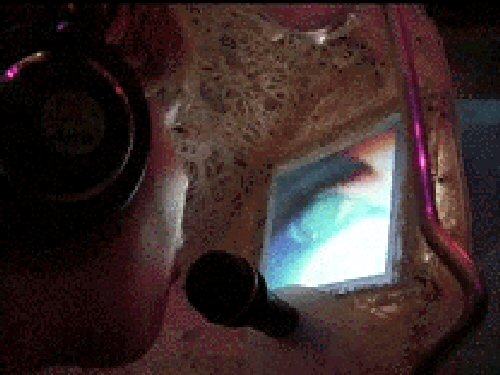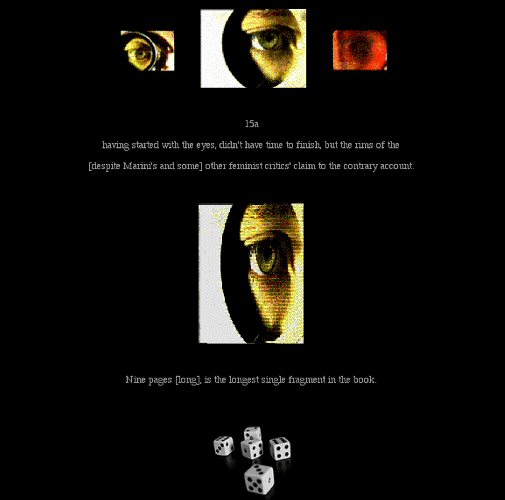Please wait a few moments while we process your request

Sharon Daniel
(Oakland, California, United-States)
Sharon Daniel is a video and new media artist working in database aesthetics and interface design. She is developing new information and communications technologies for the design of systems that enable participants to build databases based on their own experiences and to structure and interpret the data themselves.
Daniel obtained a bachelor of music degree from Baylor University, a master of music degree in opera production and direction from the University of Texas, and a master of fine arts degree from the University of Tennessee at Knoxville. She now serves as assistant professor of film and digital media at the University of California in Santa Cruz. She was formerly a lecturer in video art for the Rhode Island School of Design and the Visual Arts Program at MIT and a visiting artist at St. Martin's School of Art in London. Her installations have been exhibited in Brazil and France as well as in the United States at the MIT Center for Advanced Visual Studies in Massachusetts, The Kitchen in New York, and numerous other venues.
Daniel's main interest is what she terms "collaborative systems." She defines these systems as "experiential frameworks where individuals and technologies interact and collaborate to generate and regenerate their environment." (1). She has explored these systems throughout her installation and Internet art.
One vein of Daniel's commitment to interaction and collaboration can be traced through her earlier video work for Tod Machover's Brain Opera an interactive "opera" inspired by the work of artificial intelligence pioneer Marvin Minsky, and produced at MIT's Media Laboratory. Daniel was the visual design director, video artist and graphic designer for the opera, which premiered in 1996 in New York at the Lincoln Center Festival and through the Internet World Expo. The opera has been described as "a natural extension of the MIT Media Lab's hyperinstrument project, which began in 1986." (2). Hyperinstruments respond to an individual's unique body movements and reactions in order to add to the instrumental music and sounds generated by the musician. Before the performance of the opera, the audience enters the Mind Forest , an environment created by Machover and his colleagues that is essentially a lobby filled with hyperinstruments. People are invited to play these instruments, and the sounds are integrated into the opera. The hyperinstruments, interactive sound and video installations, reflect the voices and sounds of the audience, who help create a unique opera every single performance. The opera has been presented at Ars Electronica (Linz, Austria), the Electronic Cafe International, European Cultural Capital Celebrations (Tokyo, Japan), the NexOpera Festival (a Nexsite Project), Ebisu Garden Place, and the Kravis Center for the Performing Arts (West Palm Beach, Florida). It is now permanently installed at the New House of Music (Vienna, Austria).
Daniel has also worked independently on several installations and Internet projects Strange Attraction: Non-Logical Phase-Lock Over Space-like Intervals (1993-1994) was presented at MIT's Center for Advanced Visual Studies and published in Technology Review. Strange Attraction was created for four participants. Individuals were connected to a device that monitored their heartbeat, body rhythms, respiration and perspiration. The data retrieved by the system was then used to alter soundscapes as well as video images and sequences in the installation. Visitors wore cameras fixed on a part of their own perceiving body, which would in turn reflect the act of perceiving unique to each participant. "This experience caused participants to consider the involuntary nature of intersubjectivity in relation to the movement of perception into consciousness." (3)
Since 1995, Daniel has also been developing a series of ongoing Internet projects that draw on the collaborative systems with which she has been experimenting. Alive, Dreams and Illusions (1995), a hardware-free virtual environment for networked participants and autonomous agents, was presented at SIGGRAPH '95. Her Web project Narrative Contingencies (1997 to present) is an interactive, non-linear narrative that allows participants to contribute texts and images. In this work, Daniel uses The Ravishing of Lol V. Stein by Marguerite Duras and Subversive Intent by Susan Rubin Suleiman, two texts chosen by several women who consider that the novel realistically portrays a female character and the theoretical text addresses an issue of primary importance to women. The project includes a database into which randomly selected lines from the two works have been integrated. The program then matches a line in the database to a semiotic square that is used to select an image to represent each text. Visitors to the Narrative Contingencies Web site can play with this elaborate system and create their own narratives from the database. Images and text chosen randomly by a roll of virtual dice help construct a unique story for each visitor.
Signal-to-Noise (1996) is a conversation within the context of the World Wide Web, presenting a theoretical discourse that links images, texts and sites through networks of association.
The DeCordova Museum Virtual Gallery launched this site and the Narrative Contingencies site in February 1997. Daniel has recently finished Subtract the Sky, a public artwork conceived as a Web-based environment for producing maps. Subtract the Sky extends the context of public art by allowing individuals and communities to shape an on-line environment that is an aesthetically, intellectually and politically collaborative. The system enables users to build databases reflecting their own experiences, manipulate images, sounds and texts, and search and add information to the site's database. Subtract the Sky relies on the epistemological and aesthetic vectors of cartography to produce an archive of alternative histories. The Daniel Langlois Foundation has supported the development of the computer program required to create the work.
Daniel's main interest is what she terms "collaborative systems." She defines these systems as "experiential frameworks where individuals and technologies interact and collaborate to generate and regenerate their environment." (1). She has explored these systems throughout her installation and Internet art.
One vein of Daniel's commitment to interaction and collaboration can be traced through her earlier video work for Tod Machover's Brain Opera an interactive "opera" inspired by the work of artificial intelligence pioneer Marvin Minsky, and produced at MIT's Media Laboratory. Daniel was the visual design director, video artist and graphic designer for the opera, which premiered in 1996 in New York at the Lincoln Center Festival and through the Internet World Expo. The opera has been described as "a natural extension of the MIT Media Lab's hyperinstrument project, which began in 1986." (2). Hyperinstruments respond to an individual's unique body movements and reactions in order to add to the instrumental music and sounds generated by the musician. Before the performance of the opera, the audience enters the Mind Forest , an environment created by Machover and his colleagues that is essentially a lobby filled with hyperinstruments. People are invited to play these instruments, and the sounds are integrated into the opera. The hyperinstruments, interactive sound and video installations, reflect the voices and sounds of the audience, who help create a unique opera every single performance. The opera has been presented at Ars Electronica (Linz, Austria), the Electronic Cafe International, European Cultural Capital Celebrations (Tokyo, Japan), the NexOpera Festival (a Nexsite Project), Ebisu Garden Place, and the Kravis Center for the Performing Arts (West Palm Beach, Florida). It is now permanently installed at the New House of Music (Vienna, Austria).
Daniel has also worked independently on several installations and Internet projects Strange Attraction: Non-Logical Phase-Lock Over Space-like Intervals (1993-1994) was presented at MIT's Center for Advanced Visual Studies and published in Technology Review. Strange Attraction was created for four participants. Individuals were connected to a device that monitored their heartbeat, body rhythms, respiration and perspiration. The data retrieved by the system was then used to alter soundscapes as well as video images and sequences in the installation. Visitors wore cameras fixed on a part of their own perceiving body, which would in turn reflect the act of perceiving unique to each participant. "This experience caused participants to consider the involuntary nature of intersubjectivity in relation to the movement of perception into consciousness." (3)
Since 1995, Daniel has also been developing a series of ongoing Internet projects that draw on the collaborative systems with which she has been experimenting. Alive, Dreams and Illusions (1995), a hardware-free virtual environment for networked participants and autonomous agents, was presented at SIGGRAPH '95. Her Web project Narrative Contingencies (1997 to present) is an interactive, non-linear narrative that allows participants to contribute texts and images. In this work, Daniel uses The Ravishing of Lol V. Stein by Marguerite Duras and Subversive Intent by Susan Rubin Suleiman, two texts chosen by several women who consider that the novel realistically portrays a female character and the theoretical text addresses an issue of primary importance to women. The project includes a database into which randomly selected lines from the two works have been integrated. The program then matches a line in the database to a semiotic square that is used to select an image to represent each text. Visitors to the Narrative Contingencies Web site can play with this elaborate system and create their own narratives from the database. Images and text chosen randomly by a roll of virtual dice help construct a unique story for each visitor.
Signal-to-Noise (1996) is a conversation within the context of the World Wide Web, presenting a theoretical discourse that links images, texts and sites through networks of association.
The DeCordova Museum Virtual Gallery launched this site and the Narrative Contingencies site in February 1997. Daniel has recently finished Subtract the Sky, a public artwork conceived as a Web-based environment for producing maps. Subtract the Sky extends the context of public art by allowing individuals and communities to shape an on-line environment that is an aesthetically, intellectually and politically collaborative. The system enables users to build databases reflecting their own experiences, manipulate images, sounds and texts, and search and add information to the site's database. Subtract the Sky relies on the epistemological and aesthetic vectors of cartography to produce an archive of alternative histories. The Daniel Langlois Foundation has supported the development of the computer program required to create the work.
Angela Plohman © 2000 FDL
(1) Sharon Daniel, "Database Aesthetics: Issues of Organization and Category in Online Art", August 8, 2000.
(2) Scott Wilkinson, "The Phantom of the Brain Opera", Electronic Musician, January 1997.
(3) Sharon Daniel, Strange Attraction: Non-Logical Phase-Lock Over Space-like Intervals, September 1, 2000.
Related pages:
 Sharon Daniel, Subtract the Sky
Sharon Daniel, Subtract the SkySubtract the Sky is a public artwork conceived as a Web-based environment for producing maps.
 Sara Diamond
Sara DiamondSara Diamond was born in 1954 in New York City and later moved to Canada with her family.
External links:
Sharon Daniel :
http://artsites.ucsc.edu/sdaniel/
http://artsites.ucsc.edu/sdaniel/
Brain Opera :
http://web.media.mit.edu/~joep/TTT.BO/inde...
http://web.media.mit.edu/~joep/TTT.BO/inde...
Marvin Minsky :
http://web.media.mit.edu/~minsky/
http://web.media.mit.edu/~minsky/
Strange Attraction: Non-Logical Phase-Lock Over Space-like Intervals:
http://arts.ucsc.edu/sdaniel/docu/SAfrmset...
http://arts.ucsc.edu/sdaniel/docu/SAfrmset...

















